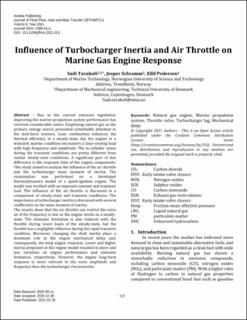| dc.contributor.author | Tavakoli, Sadi | |
| dc.contributor.author | Schramm, Jesper | |
| dc.contributor.author | Pedersen, Eilif | |
| dc.date.accessioned | 2021-06-10T07:34:56Z | |
| dc.date.available | 2021-06-10T07:34:56Z | |
| dc.date.created | 2021-06-09T14:52:46Z | |
| dc.date.issued | 2021 | |
| dc.identifier.citation | Journal of Fluid Flow, Heat and Mass Transfer (JFFHMT). 2021, 8, 112-123. | en_US |
| dc.identifier.issn | 2368-6111 | |
| dc.identifier.uri | https://hdl.handle.net/11250/2758756 | |
| dc.description.abstract | Due to the current emission legislation, improving the marine propulsion system performance has received considerable notice. Employing natural gas as the primary energy source presented remarkable attention in the lean-burn mixture. Lean combustion enhances the thermal efficiency in a steady-state, but the engine in a transient marine condition encounters a time-varying load with high frequency and amplitude. The in-cylinder states during the transient conditions are pretty different from similar steady-state conditions. A significant part of this difference is the response time of the engine components. This study aimed to analyze the influence of the air throttle and the turbocharger mass moment of inertia. The examination was performed on a developed thermodynamics model of a spark-ignition engine. The model was verified with an imposed constant and transient load. The influence of the air throttle is discussed in a comparison of steady-state and transient conditions. The importance of turbocharger inertia is discussed with several coefficients on the mass moment of inertia.
The results show that the air throttle can restrict the extra air if the frequency is low or the engine works in a steady-state. The emission formation is also reduced with the throttle during lower loads of the steady-state, but the throttle has a negligible influence during the rapid transient condition.Moreover, changing the shaft inertia plays a dominant role in the engine mechanical delay and, consequently, the total engine response. Lower and higher inertia proposed on the engine model resulted in more and less variation on engine performance and emission formation, respectively. However, the engine long-term response is more relevant to the wave amplitude and frequency than the turbocharger characteristic. | en_US |
| dc.language.iso | eng | en_US |
| dc.publisher | Avestia Publishing | en_US |
| dc.rights | Navngivelse 4.0 Internasjonal | * |
| dc.rights.uri | http://creativecommons.org/licenses/by/4.0/deed.no | * |
| dc.title | Influence of Turbocharger Inertia and Air Throttle on Marine Gas Engine Response | en_US |
| dc.type | Journal article | en_US |
| dc.description.version | publishedVersion | en_US |
| dc.source.pagenumber | 112-123 | en_US |
| dc.source.volume | 8 | en_US |
| dc.source.journal | Journal of Fluid Flow, Heat and Mass Transfer (JFFHMT) | en_US |
| dc.identifier.doi | 10.11159/jffhmt.2021.013 | |
| dc.identifier.cristin | 1914875 | |
| dc.description.localcode | © Copyright 2021 Authors - This is an Open Access article published under the Creative Commons Attribution License terms Creative Commons Attribution License terms. Unrestricted use, distribution, and reproduction in any medium are permitted, provided the original work is properly cited. | en_US |
| cristin.ispublished | true | |
| cristin.fulltext | original | |
| cristin.qualitycode | 0 | |

